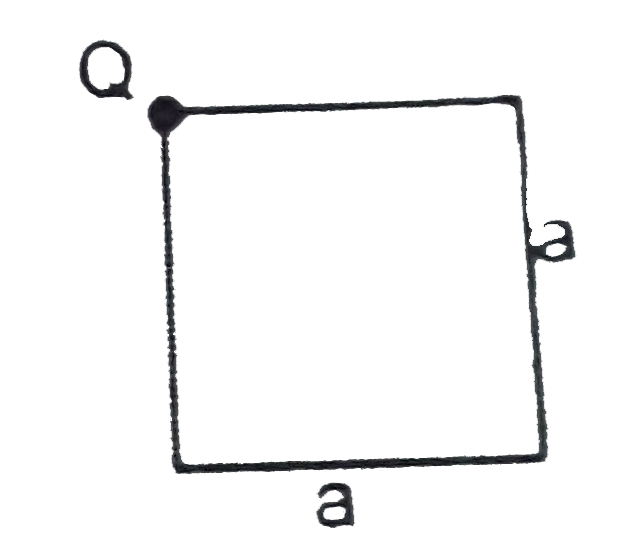A charge Q is placed at the centre of a square If electric field intensity due to the charge at the corners of the square is E1 and the intensity at the mid point of the sidde of square is E2 then the ratio of E1E2 will be
12√2
√2
12
2
The correct Answer is:C
To solve the problem, we need to find the ratio of the electric field intensities E1 and E2 at the corners and midpoints of the sides of a square, respectively, when a charge Q is placed at the center of the square.
1. Identify the Geometry:
- Consider a square with side length A.
- The charge Q is at the center of the square.
2. Calculate the Distance to the Corners:
- The distance from the center of the square to any corner can be calculated using the Pythagorean theorem.
- The diagonal of the square is √A2+A2=A√2.
- Therefore, the distance d1 from the center to a corner is:
d1=A√22=A√2
3. Calculate the Distance to the Midpoints of the Sides:
- The distance from the center of the square to the midpoint of any side is half the side length:
- Therefore, the distance d2 is:
d2=A2
4. Calculate the Electric Field Intensities:
- The electric field intensity E due to a point charge Q at a distance r is given by:
E=kQr2
- For the corners (distance d1):
E1=kQd21=kQ(A√2)2=kQA22=2kQA2
- For the midpoints (distance d2):
E2=kQd22=kQ(A2)2=kQA24=4kQA2
5. Calculate the Ratio E1E2:
- Now, we can find the ratio:
E1E2=2kQA24kQA2=24=12
Final Answer:
The ratio E1E2 is 12.
- Consider a square with side length A.
- The charge Q is at the center of the square.
- The distance from the center of the square to any corner can be calculated using the Pythagorean theorem.
- The diagonal of the square is √A2+A2=A√2.
- Therefore, the distance d1 from the center to a corner is:
d1=A√22=A√2
- The distance from the center of the square to the midpoint of any side is half the side length:
- Therefore, the distance d2 is:
d2=A2
- The electric field intensity E due to a point charge Q at a distance r is given by:
E=kQr2
- For the corners (distance d1):
E1=kQd21=kQ(A√2)2=kQA22=2kQA2
- For the midpoints (distance d2):
E2=kQd22=kQ(A2)2=kQA24=4kQA2
- Now, we can find the ratio:
E1E2=2kQA24kQA2=24=12
The ratio E1E2 is 12.
Similar Questions
Knowledge Check
- Question 1 - Select One
The electric field at the centre of a square having equal charge q at each of the coner (side of square a )
A8kqa2B2kqa2CzeroD4kq(a/√2)2 - Question 2 - Select One
Four charges +Q,−Q,+Q,−Q are placed at the corners of a square taken in order. At the centre of the square
AE=0,V=0BE=0,V≠0CE≠0,V=0DE=0,V≠0 - Question 3 - Select One
Four identical charges i.e. q is placed at the corners of a square of side a. The charge Q that must be placed at the centre of the square such that the whole system of charges in equilibrium is
Aq4Bq4[2√2+1]C−q4[2√2+1]D−q4[3√3+1]
" Electric field intensity due to a point charge " "q" ' at a distance 'r' from it is "
View SolutionDerive an expression for electric field intensity E due to an infinite place sheet of charge.
View SolutionFour point charges are placed at the corners of a square of side l. Calculate potential at the centre of square.
 View Solution
View SolutionThe electric field intensity at point near and outside the surface of a charged conductor of any shate is E1 the elecric field intensity due to uniformly charged conductor of any shape is E1 the electric field intensity due ot uniformly charged infinite thin plane sheet is E2 the relation between E1 and E2 is
View SolutionThe electric field intensity at point near and outside the surface of a charged conductor of any shate is E1 the elecric field intensity due to uniformly charged conductor of any shape is E1 the electric field intensity due ot uniformly charged infinite thin plane sheet is E2 the relation between E1 and E2 is
View Solution


